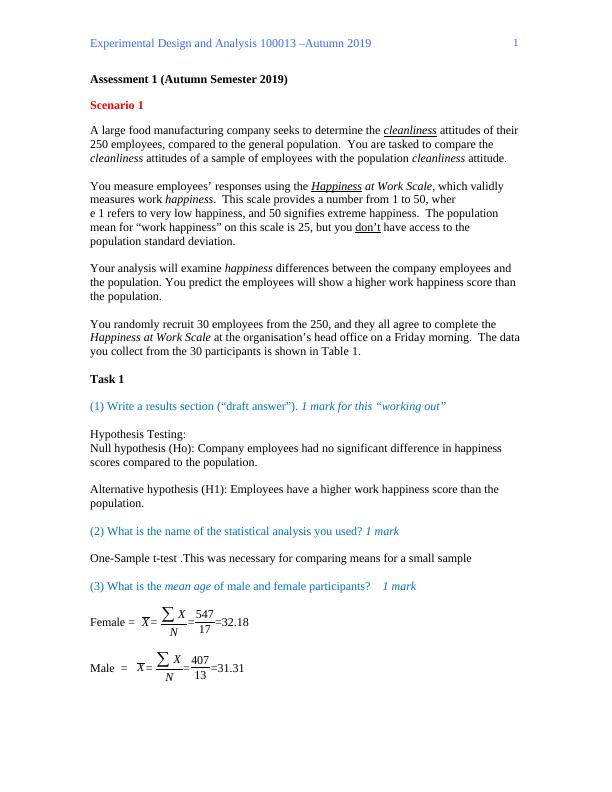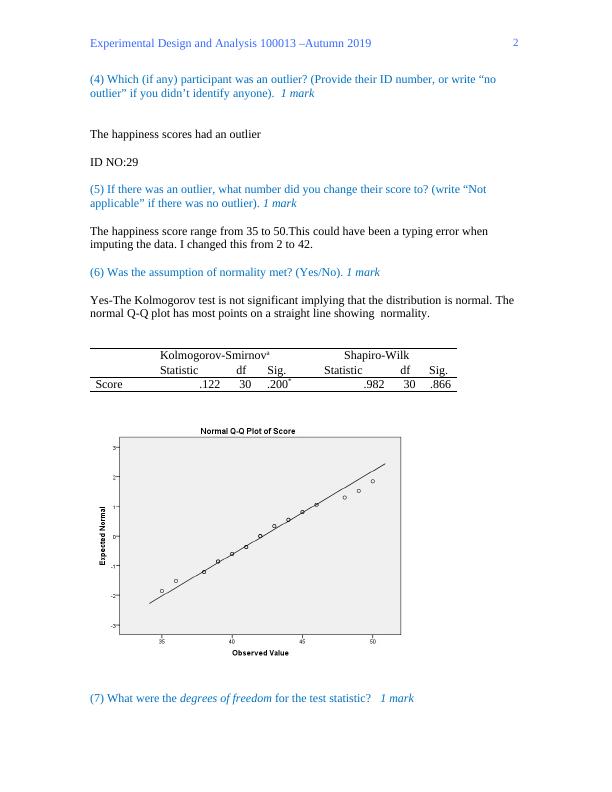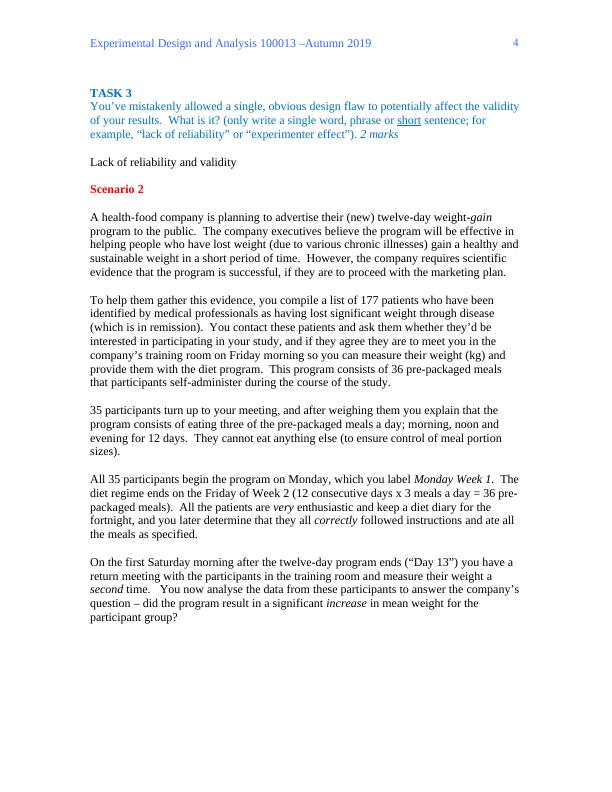Experimental Design and Analysis Assessment 1 (Autumn Semester 2019)
Added on 2022-11-14
19 Pages5249 Words287 Views
Experimental Design and Analysis 100013 –Autumn 2019
Assessment 1 (Autumn Semester 2019)
Scenario 1
A large food manufacturing company seeks to determine the cleanliness attitudes of their
250 employees, compared to the general population. You are tasked to compare the
cleanliness attitudes of a sample of employees with the population cleanliness attitude.
You measure employees’ responses using the Happiness at Work Scale, which validly
measures work happiness. This scale provides a number from 1 to 50, wher
e 1 refers to very low happiness, and 50 signifies extreme happiness. The population
mean for “work happiness” on this scale is 25, but you don’t have access to the
population standard deviation.
Your analysis will examine happiness differences between the company employees and
the population. You predict the employees will show a higher work happiness score than
the population.
You randomly recruit 30 employees from the 250, and they all agree to complete the
Happiness at Work Scale at the organisation’s head office on a Friday morning. The data
you collect from the 30 participants is shown in Table 1.
Task 1
(1) Write a results section (“draft answer”). 1 mark for this “working out”
Hypothesis Testing:
Null hypothesis (Ho): Company employees had no significant difference in happiness
scores compared to the population.
Alternative hypothesis (H1): Employees have a higher work happiness score than the
population.
(2) What is the name of the statistical analysis you used? 1 mark
One-Sample t-test .This was necessary for comparing means for a small sample
(3) What is the mean age of male and female participants? 1 mark
Female = X = ∑ X
N = 547
17 =32.18
Male = X = ∑ X
N = 407
13 =31.31
1
Assessment 1 (Autumn Semester 2019)
Scenario 1
A large food manufacturing company seeks to determine the cleanliness attitudes of their
250 employees, compared to the general population. You are tasked to compare the
cleanliness attitudes of a sample of employees with the population cleanliness attitude.
You measure employees’ responses using the Happiness at Work Scale, which validly
measures work happiness. This scale provides a number from 1 to 50, wher
e 1 refers to very low happiness, and 50 signifies extreme happiness. The population
mean for “work happiness” on this scale is 25, but you don’t have access to the
population standard deviation.
Your analysis will examine happiness differences between the company employees and
the population. You predict the employees will show a higher work happiness score than
the population.
You randomly recruit 30 employees from the 250, and they all agree to complete the
Happiness at Work Scale at the organisation’s head office on a Friday morning. The data
you collect from the 30 participants is shown in Table 1.
Task 1
(1) Write a results section (“draft answer”). 1 mark for this “working out”
Hypothesis Testing:
Null hypothesis (Ho): Company employees had no significant difference in happiness
scores compared to the population.
Alternative hypothesis (H1): Employees have a higher work happiness score than the
population.
(2) What is the name of the statistical analysis you used? 1 mark
One-Sample t-test .This was necessary for comparing means for a small sample
(3) What is the mean age of male and female participants? 1 mark
Female = X = ∑ X
N = 547
17 =32.18
Male = X = ∑ X
N = 407
13 =31.31
1

Experimental Design and Analysis 100013 –Autumn 2019
(4) Which (if any) participant was an outlier? (Provide their ID number, or write “no
outlier” if you didn’t identify anyone). 1 mark
The happiness scores had an outlier
ID NO:29
(5) If there was an outlier, what number did you change their score to? (write “Not
applicable” if there was no outlier). 1 mark
The happiness score range from 35 to 50.This could have been a typing error when
imputing the data. I changed this from 2 to 42.
(6) Was the assumption of normality met? (Yes/No). 1 mark
Yes-The Kolmogorov test is not significant implying that the distribution is normal. The
normal Q-Q plot has most points on a straight line showing normality.
Kolmogorov-Smirnova Shapiro-Wilk
Statistic df Sig. Statistic df Sig.
Score .122 30 .200* .982 30 .866
(7) What were the degrees of freedom for the test statistic? 1 mark
2
(4) Which (if any) participant was an outlier? (Provide their ID number, or write “no
outlier” if you didn’t identify anyone). 1 mark
The happiness scores had an outlier
ID NO:29
(5) If there was an outlier, what number did you change their score to? (write “Not
applicable” if there was no outlier). 1 mark
The happiness score range from 35 to 50.This could have been a typing error when
imputing the data. I changed this from 2 to 42.
(6) Was the assumption of normality met? (Yes/No). 1 mark
Yes-The Kolmogorov test is not significant implying that the distribution is normal. The
normal Q-Q plot has most points on a straight line showing normality.
Kolmogorov-Smirnova Shapiro-Wilk
Statistic df Sig. Statistic df Sig.
Score .122 30 .200* .982 30 .866
(7) What were the degrees of freedom for the test statistic? 1 mark
2

Experimental Design and Analysis 100013 –Autumn 2019
d.f =n-1= 29
(8) What was the value of the test statistic? 1 mark
Test Value = 0
t
d
f
Sig.
(2-
taile
d)
Mean
Differen
ce
95%
Confidence
Interval of
the
Difference
Low
er
Upp
er
Scor
e
64.992 2
9
.000 42.200 40.8
7
43.5
3
Test statistic t =64.99
(9) What was the probability value associated with the test statistic? (use “p < 0.001” if
the SPSS output shows “0.000” in the probability box). 1 mark
Probability value :p < 0.001
(10) What was the value of the Cohen’s d effect size? (write “Not applicable” if effect
size is not relevant to the Scenario 1 analysis). 1 mark
Since this is not grouped then the cohen d effect size was not considered applicable.
(11) Based on the value of Cohen’s d you might have calculated, how would you describe
the effect size? (small, medium, large or “not applicable”). 1 mark
Since this is not grouped then the cohen d effect size with not be applicable.
TASK 2
Circle the number next to the statement which most accurately summarises the research
findings. 2 marks
(1) The mean happiness rating of the sample was significantly higher than the population
mean.
3
d.f =n-1= 29
(8) What was the value of the test statistic? 1 mark
Test Value = 0
t
d
f
Sig.
(2-
taile
d)
Mean
Differen
ce
95%
Confidence
Interval of
the
Difference
Low
er
Upp
er
Scor
e
64.992 2
9
.000 42.200 40.8
7
43.5
3
Test statistic t =64.99
(9) What was the probability value associated with the test statistic? (use “p < 0.001” if
the SPSS output shows “0.000” in the probability box). 1 mark
Probability value :p < 0.001
(10) What was the value of the Cohen’s d effect size? (write “Not applicable” if effect
size is not relevant to the Scenario 1 analysis). 1 mark
Since this is not grouped then the cohen d effect size was not considered applicable.
(11) Based on the value of Cohen’s d you might have calculated, how would you describe
the effect size? (small, medium, large or “not applicable”). 1 mark
Since this is not grouped then the cohen d effect size with not be applicable.
TASK 2
Circle the number next to the statement which most accurately summarises the research
findings. 2 marks
(1) The mean happiness rating of the sample was significantly higher than the population
mean.
3

Experimental Design and Analysis 100013 –Autumn 2019
TASK 3
You’ve mistakenly allowed a single, obvious design flaw to potentially affect the validity
of your results. What is it? (only write a single word, phrase or short sentence; for
example, “lack of reliability” or “experimenter effect”). 2 marks
Lack of reliability and validity
Scenario 2
A health-food company is planning to advertise their (new) twelve-day weight-gain
program to the public. The company executives believe the program will be effective in
helping people who have lost weight (due to various chronic illnesses) gain a healthy and
sustainable weight in a short period of time. However, the company requires scientific
evidence that the program is successful, if they are to proceed with the marketing plan.
To help them gather this evidence, you compile a list of 177 patients who have been
identified by medical professionals as having lost significant weight through disease
(which is in remission). You contact these patients and ask them whether they’d be
interested in participating in your study, and if they agree they are to meet you in the
company’s training room on Friday morning so you can measure their weight (kg) and
provide them with the diet program. This program consists of 36 pre-packaged meals
that participants self-administer during the course of the study.
35 participants turn up to your meeting, and after weighing them you explain that the
program consists of eating three of the pre-packaged meals a day; morning, noon and
evening for 12 days. They cannot eat anything else (to ensure control of meal portion
sizes).
All 35 participants begin the program on Monday, which you label Monday Week 1. The
diet regime ends on the Friday of Week 2 (12 consecutive days x 3 meals a day = 36 pre-
packaged meals). All the patients are very enthusiastic and keep a diet diary for the
fortnight, and you later determine that they all correctly followed instructions and ate all
the meals as specified.
On the first Saturday morning after the twelve-day program ends (“Day 13”) you have a
return meeting with the participants in the training room and measure their weight a
second time. You now analyse the data from these participants to answer the company’s
question – did the program result in a significant increase in mean weight for the
participant group?
4
TASK 3
You’ve mistakenly allowed a single, obvious design flaw to potentially affect the validity
of your results. What is it? (only write a single word, phrase or short sentence; for
example, “lack of reliability” or “experimenter effect”). 2 marks
Lack of reliability and validity
Scenario 2
A health-food company is planning to advertise their (new) twelve-day weight-gain
program to the public. The company executives believe the program will be effective in
helping people who have lost weight (due to various chronic illnesses) gain a healthy and
sustainable weight in a short period of time. However, the company requires scientific
evidence that the program is successful, if they are to proceed with the marketing plan.
To help them gather this evidence, you compile a list of 177 patients who have been
identified by medical professionals as having lost significant weight through disease
(which is in remission). You contact these patients and ask them whether they’d be
interested in participating in your study, and if they agree they are to meet you in the
company’s training room on Friday morning so you can measure their weight (kg) and
provide them with the diet program. This program consists of 36 pre-packaged meals
that participants self-administer during the course of the study.
35 participants turn up to your meeting, and after weighing them you explain that the
program consists of eating three of the pre-packaged meals a day; morning, noon and
evening for 12 days. They cannot eat anything else (to ensure control of meal portion
sizes).
All 35 participants begin the program on Monday, which you label Monday Week 1. The
diet regime ends on the Friday of Week 2 (12 consecutive days x 3 meals a day = 36 pre-
packaged meals). All the patients are very enthusiastic and keep a diet diary for the
fortnight, and you later determine that they all correctly followed instructions and ate all
the meals as specified.
On the first Saturday morning after the twelve-day program ends (“Day 13”) you have a
return meeting with the participants in the training room and measure their weight a
second time. You now analyse the data from these participants to answer the company’s
question – did the program result in a significant increase in mean weight for the
participant group?
4

End of preview
Want to access all the pages? Upload your documents or become a member.
Related Documents
Experimental Design and Analysis and Using SPSS - Assignmentlg...
|53
|8056
|92
Calculating t-tests for Independent and Paired Samples - Exercise 31 and 32lg...
|9
|1866
|331
Independent and Paired Samples T-Test: Assumptions, Means, and Interpretationlg...
|7
|1769
|496
Data Analysis of Koalas- doclg...
|20
|3290
|133
Working with Inferential Statisticslg...
|7
|879
|480
StatCrunch Assignment 3lg...
|5
|1011
|137